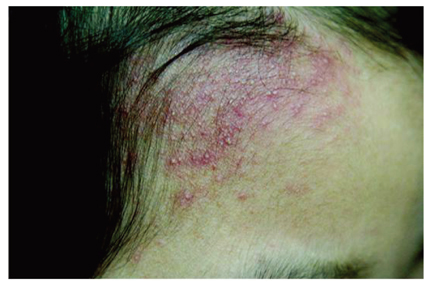J Korean Med Assoc.
2019 Apr;62(4):187-192. 10.5124/jkma.2019.62.4.187.
Heat-related skin disease
- Affiliations
-
- 1Department of Dermatology, Dong-A University College of Medicine, Busan, Korea. khkim@dau.ac.kr
- KMID: 2442733
- DOI: http://doi.org/10.5124/jkma.2019.62.4.187
Abstract
- Skin disease can be caused by high temperature, and it is related to the temperature regulation mechanism of human body, adaptation reaction to temperature change, and health problems due to the recent problematic climate change. In hyperthermia, hot and dry skin is typical manifestation, and sometimes the skin color turns red. On the other hand, the skin color can become pale in severe febrile convulsion. Burn is a skin damage caused by heat, and not only the skin but also the underlying tissues can be destroyed in severe case. It is important to determine the degree and extent of the burn to treat adequately. In the case of severe burns, systemic treatment and prevention of infection or shock should be needed. Miliaria, also called "sweat rash," occurs when the sweat is accumulated as the sweat gland is closed and sweat cannot be secreted to the surface of the skin. The basis of treating miliaria is to keep the patient in a cool environment. Erythema ab igne is defined as a network of hyperpigmentation that occurs after prolonged exposure to heat that is not enough to cause burn. It may disappear when exposure to heat is interrupted, but it may remain permanently. The extent and mechanism of heat-induced skin disease very diverse and it should be carefully assessed for the severity of each disease, the treatment method and prognosis.
MeSH Terms
Figure
Reference
-
1. Jacqueline MJ. Disorders associated with physical agents: heat, cold, radiation and trauma. In : Elder DE, Elenitsas R, Johnson BL, Murphy GF, Xu X, editors. Lever's histopathology of the skin. 10th ed. Philadelphia: Lippincott Williams and Wilkins;2009. p. 343–387.2. James WD, Berger TG, Elston DM. Dermatoses resulting form physical factors. In : James WD, Berger TG, Elston DM, editors. Andrews' diseases of the skin: clinical dermatology. 11st ed. Philadelphia: Saunders;2011. p. 18–44.3. National Institute for Occupational Safety and Health. Heat stress: heat related illness [Internet]. Atlanta: Centers for Disease Control and Prevention;2018. cited 2019 Mar 4. Available from: https://www.cdc.gov/niosh/topics/heatstress/heatrelillness.html.4. National Institute for Occupational Safety and Health. Heat Stress - Heat Related Illness.
- Full Text Links
- Actions
-
Cited
- CITED
-
- Close
- Share
- Similar articles
-
- Diagnosis and treatment of patients with heat-related illnesses
- Factors affecting heat-related diseases in outdoor workers exposed to extreme heat
- Antibody response against 65kD heat shock protein in Kawasaki disease
- Expression of Heat Shock Protein 70 m-RNA in Rat Bladder Overdistended by Diuresis
- An experimental system on heart resistance by split dose hyperthermia




